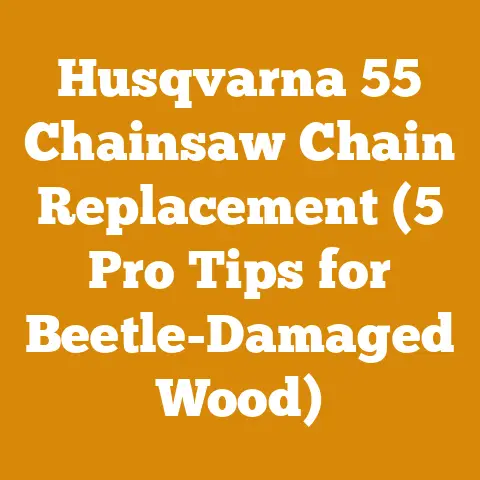Stihl Helmet Ear Muffs Replacement Guide (3 Pro Logging Tips)
Ever wondered why your Stihl helmet ear muffs seem to give up the ghost right when you need them most?
Are you tired of fiddling with uncomfortable, ineffective hearing protection while wrestling with a chainsaw?
I get it.
I’ve been there, covered in sawdust, frustrated with equipment that just doesn’t hold up.
Changing those ear muffs isn’t just about comfort; it’s about safety, efficiency, and peace of mind in a noisy environment.
This guide isn’t just about replacing ear muffs; it’s about optimizing your entire wood processing experience.
The Global Wood Processing Landscape: A Noisy Reality
Before we dive into the nitty-gritty of Stihl helmet ear muff replacements, let’s take a quick look at the bigger picture.
The global wood processing and logging industry is a multi-billion dollar enterprise, with significant growth projected in the coming years.
According to recent reports, the demand for wood products, including lumber, firewood, and engineered wood, is steadily increasing, fueled by construction, furniture manufacturing, and renewable energy initiatives.
However, this booming industry comes with inherent risks, particularly noise-induced hearing loss.
Chainsaws, wood chippers, and other heavy machinery generate extremely high noise levels, often exceeding the permissible exposure limits set by regulatory agencies.
Studies have shown that prolonged exposure to these noise levels can lead to irreversible hearing damage, tinnitus, and other auditory problems.
That’s where reliable hearing protection becomes absolutely crucial.
Why Stihl Helmet Ear Muffs Matter: More Than Just a Comfort Item
Stihl is a name synonymous with quality and durability in the world of logging and wood processing.
Their helmets and ear muffs are designed to withstand the rigors of demanding work environments.
But even the best equipment eventually needs maintenance and replacement parts.
Here’s why keeping your Stihl helmet ear muffs in top condition is essential:
- Hearing Protection: This is the most obvious and important reason.
Properly functioning ear muffs significantly reduce the noise levels reaching your ears, protecting you from potential hearing damage. - Comfort: Comfortable ear muffs allow you to focus on the task at hand without distractions.
Ill-fitting or worn-out ear muffs can cause discomfort, pressure, and even headaches, impacting your concentration and productivity. - Safety: When you can hear clearly (or at least, not be overwhelmed by noise), you’re more aware of your surroundings and potential hazards.
This is especially critical when operating heavy machinery or working in teams. - Compliance: Many workplaces have regulations regarding hearing protection.
Using properly functioning ear muffs ensures you’re compliant with these regulations and avoid potential fines or penalties. - Longevity of your helmet: Keeping all parts of your helmet in good condition will extend the life of your investment.
Understanding the User Intent: What You’re Really Looking For
- Clear and concise instructions: You want a step-by-step guide that’s easy to follow, even if you’re not a mechanical expert.
- Practical tips and tricks: You’re looking for insider knowledge that can save you time, effort, and potential headaches.
- Troubleshooting advice: You want to know what to do if things don’t go according to plan.
- Product recommendations: You need guidance on choosing the right replacement ear muffs for your specific Stihl helmet model.
- Expert advice: You value the insights of experienced professionals who have “been there, done that.”
That’s exactly what I aim to deliver in this guide.
3 Pro Logging Tips Before We Start: Wisdom For The Woods
Before we get our hands dirty with the replacement process, let’s pause and glean some wisdom from the seasoned pros.
These tips are born from years of experience in the woods, and they can make a significant difference in your safety, efficiency, and overall wood processing endeavors.
Respect the Wood: Wood is a living material, and it deserves respect.
This means understanding its properties, handling it with care, and using it responsibly.
I’ve seen too many accidents happen because someone underestimated the weight or unpredictability of a log.
Always assess the situation carefully before making a cut or moving a piece of wood.- Data Point: Wood density varies greatly by species.
For example, oak is significantly denser than pine, requiring different handling techniques and tools. -
Sharpen Your Senses (and Your Tools): A dull chainsaw is a dangerous chainsaw.
Similarly, a distracted or fatigued worker is a liability.
Sharpen your tools regularly and take frequent breaks to stay alert and focused.
I once spent an entire day fighting with a dull chainsaw, only to realize that I was wasting energy and increasing my risk of injury. -
Statistic: Studies have shown that sharp chainsaws can reduce cutting time by up to 30% and significantly decrease the risk of kickback.
- Plan Your Escape Route: This is a fundamental principle of tree felling, but it applies to all aspects of wood processing.
Always have a clear escape route in mind in case of an emergency.
This could be a falling tree, a runaway log, or a sudden equipment malfunction.
I’ve had to use my escape route more than once, and it’s always been a lifesaver.
- Data Point: Wood density varies greatly by species.
Navigating the Noise: Understanding NRR and Hearing Protection Standards
Before we select our replacement ear muffs, it’s important to understand Noise Reduction Rating (NRR).
NRR is a measurement of how well a hearing protection device reduces noise levels.
It’s expressed in decibels (dB), and the higher the NRR, the more noise reduction the device provides.
- EPA Requirements: The Environmental Protection Agency (EPA) mandates that all hearing protection devices sold in the United States must be labeled with their NRR.
- OSHA Guidelines: The Occupational Safety and Health Administration (OSHA) sets permissible exposure limits (PELs) for noise in the workplace.
Employers are required to provide hearing protection to employees who are exposed to noise levels exceeding these limits. - NRR Limitations: It’s important to note that the NRR is determined in a laboratory setting and may not accurately reflect real-world performance.
Factors such as fit, improper use, and environmental conditions can affect the actual noise reduction achieved.
When selecting replacement ear muffs, consider the noise levels you’ll be exposed to and choose a product with an appropriate NRR.
Also, make sure the ear muffs fit properly and are worn correctly to maximize their effectiveness.
Choosing the Right Replacement Ear Muffs: A Buyer’s Guide
Not all ear muffs are created equal.
When selecting replacement ear muffs for your Stihl helmet, consider the following factors:
- Compatibility: Ensure that the ear muffs are specifically designed to fit your Stihl helmet model.
Stihl helmets often have proprietary attachment mechanisms, so generic ear muffs may not work. - NRR: Choose an NRR that’s appropriate for the noise levels you’ll be exposed to.
As a general rule, higher is better, but comfort is also important. - Comfort: Look for ear muffs with soft, comfortable ear cushions and an adjustable headband.
You’ll be wearing these for extended periods, so comfort is essential. - Durability: Opt for ear muffs made from high-quality materials that can withstand the rigors of logging and wood processing.
- Features: Some ear muffs come with additional features, such as built-in radios or Bluetooth connectivity.
These features can enhance your work experience, but they may also add to the cost. - Price: Ear muff prices can vary widely, so set a budget and stick to it.
Remember that quality and durability are often worth the extra investment.
Popular Stihl Ear Muff Models:
- Stihl Pro Mark: Known for their high NRR and robust construction.
- Stihl Function Basic: A more affordable option that still provides adequate hearing protection.
- Stihl Concept 23: Designed for comfort and extended wear.
Step-by-Step Guide: Replacing Your Stihl Helmet Ear Muffs
Alright, let’s get down to business.
Here’s a detailed, step-by-step guide to replacing your Stihl helmet ear muffs:
Tools You’ll Need:
- New Stihl helmet ear muffs (compatible with your helmet model)
- Flathead screwdriver (optional, depending on the attachment mechanism)
- Clean cloth
Step 1: Prepare Your Work Area
Find a clean, well-lit workspace where you can comfortably work on your helmet.
This will help you avoid losing any small parts and ensure you can see what you’re doing.
Step 2: Remove the Old Ear Muffs
The removal process will vary depending on your Stihl helmet model.
Here are a few common methods:
- Snap-On: Some ear muffs simply snap into place.
Gently pull the ear muffs away from the helmet until they detach. - Screw-On: Other ear muffs are secured with screws.
Use a flathead screwdriver to loosen and remove the screws. - Clip-On: Some models feature clips that hold the ear muffs in place.
Use your fingers or a screwdriver to gently release the clips.
Important: Pay close attention to how the old ear muffs are attached.
This will help you install the new ones correctly.
Step 3: Clean the Helmet Attachment Points
Use a clean cloth to wipe down the attachment points on your helmet.
This will remove any dirt, dust, or debris that could interfere with the new ear muffs.
Step 4: Install the New Ear Muffs
Align the new ear muffs with the attachment points on your helmet.
Follow the reverse of the removal process to secure them in place:
- Snap-On: Press the ear muffs firmly into the attachment points until they snap into place.
- Screw-On: Align the ear muffs with the screw holes and tighten the screws.
- Clip-On: Attach the ear muffs to the clips until they click into place.
Important: Make sure the ear muffs are securely attached and that they don’t wobble or feel loose.
Step 5: Test the Fit and Function
Put on your helmet and adjust the ear muffs until they fit comfortably and provide adequate hearing protection.
Make sure the ear cushions seal properly around your ears.
Step 6: Double-Check Your Work
Before you head back to work, double-check that the ear muffs are securely attached and that they function correctly.
Give them a gentle tug to ensure they won’t come loose during use.
Troubleshooting: Common Problems and Solutions
Even with the best instructions, things can sometimes go wrong.
Here are a few common problems you might encounter during the ear muff replacement process and how to solve them:
Problem: The new ear muffs don’t fit properly.
- Solution: Double-check that you’ve purchased the correct ear muffs for your Stihl helmet model.
If you’re unsure, consult the Stihl website or contact a Stihl dealer. -
Problem: The ear muffs are difficult to attach.
-
Solution: Make sure the attachment points on your helmet are clean and free of debris.
Also, check that you’re aligning the ear muffs correctly. -
Problem: The ear muffs are loose or wobbly.
-
Solution: Tighten the screws or clips that hold the ear muffs in place.
If the screws are stripped or the clips are broken, you may need to replace them. -
Problem: The ear cushions are uncomfortable.
-
Solution: Try adjusting the headband to improve the fit.
If the ear cushions are worn out or damaged, you may need to replace them.
- Solution: Double-check that you’ve purchased the correct ear muffs for your Stihl helmet model.
Maintaining Your Ear Muffs: Extending Their Lifespan
To get the most out of your Stihl helmet ear muffs, it’s important to maintain them properly.
Here are a few tips:
- Clean them regularly: Wipe down the ear muffs with a damp cloth to remove dirt, dust, and sweat.
- Store them properly: When you’re not using your helmet, store it in a clean, dry place.
Avoid exposing the ear muffs to extreme temperatures or direct sunlight. - Inspect them regularly: Check the ear muffs for signs of wear and tear, such as cracks, tears, or loose parts.
Replace any damaged parts immediately. - Replace the ear cushions: The ear cushions are the most vulnerable part of the ear muffs.
Replace them every 6-12 months, or more frequently if they become damaged or worn out.
Beyond Ear Muffs: A Holistic Approach to Hearing Protection
While replacing your ear muffs is a crucial step, it’s important to remember that hearing protection is more than just a piece of equipment.
It’s a holistic approach that involves understanding the risks, taking preventative measures, and prioritizing your long-term hearing health.
- Noise Monitoring: Regularly monitor the noise levels in your work environment.
This will help you identify areas where hearing protection is most critical. - Hearing Tests: Get regular hearing tests to detect any early signs of hearing loss.
Early detection is key to preventing further damage. - Education and Training: Educate yourself and your colleagues about the risks of noise-induced hearing loss and the importance of proper hearing protection.
- Engineering Controls: Implement engineering controls to reduce noise levels at the source.
This could involve using quieter equipment, installing sound barriers, or modifying work processes. - Administrative Controls: Implement administrative controls to limit exposure to noise.
This could involve rotating workers, scheduling noisy tasks during off-peak hours, or providing quiet break areas.
The Firewood Factor: A Personal Story
I remember one particularly harsh winter where I was scrambling to prepare enough firewood for my family.
I was working long hours in the woods, felling trees, splitting logs, and stacking wood.
I was so focused on getting the job done that I neglected my hearing protection.
One day, I noticed a ringing in my ears that wouldn’t go away.
I went to see a doctor, who diagnosed me with tinnitus, a permanent condition caused by noise-induced hearing damage.
That experience was a wake-up call.
I realized that my hearing was precious, and I needed to take better care of it.
From that day forward, I made hearing protection a top priority.
I always wear ear muffs when operating noisy equipment, and I encourage others to do the same.
Wood Species and Firewood Quality: A Quick Guide
The type of wood you’re processing also plays a significant role in your overall experience.
Different wood species have different properties that affect their suitability for firewood.
Here’s a quick guide:
- Hardwoods: Hardwoods, such as oak, maple, and ash, are dense and burn slowly, producing a long-lasting, hot fire.
They are generally considered the best choice for firewood. - Softwoods: Softwoods, such as pine, fir, and spruce, are less dense and burn quickly, producing a shorter-lasting, less intense fire.
They are often used for kindling or starting fires. Seasoning: Regardless of the wood species, it’s important to season firewood properly before burning it.
Seasoning involves allowing the wood to dry for 6-12 months, which reduces its moisture content and improves its burning efficiency.- Data Point: Properly seasoned firewood has a moisture content of 20% or less.
- Statistic: Burning unseasoned firewood can reduce heating efficiency by up to 50% and increase the risk of chimney fires.
Case Study: The Sustainable Firewood Project
I recently consulted on a sustainable firewood project in a rural community.
The project aimed to provide affordable firewood to low-income families while also promoting sustainable forest management practices.
The project involved:
- Selective Harvesting: Harvesting trees selectively to improve forest health and biodiversity.
- Proper Seasoning: Seasoning firewood for 12 months to reduce moisture content and improve burning efficiency.
- Community Education: Educating the community about the benefits of sustainable firewood and proper burning techniques.
- Affordable Pricing: Selling firewood at an affordable price to low-income families.
The project was a success.
It provided a sustainable source of firewood to the community while also promoting responsible forest management.
Budgeting for Wood Processing: A Cost-Effective Approach
Wood processing can be an expensive endeavor, but there are ways to minimize costs.
Here are a few tips:
- Buy in Bulk: Purchase wood in bulk to save money.
- Rent Equipment: Rent equipment, such as chainsaws and log splitters, instead of buying it.
- Do it Yourself: Do as much of the work yourself as possible.
- Salvage Wood: Salvage wood from fallen trees or construction sites.
- Shop Around: Compare prices from different suppliers.
Next Steps: Resources and Suppliers
Now that you’ve replaced your Stihl helmet ear muffs and learned about wood processing, here are some additional resources and suppliers to help you on your journey:
- Stihl Dealers: Find a Stihl dealer near you for replacement parts and equipment.
- Logging Supply Stores: Visit a logging supply store for a wide selection of tools and equipment.
- Forestry Associations: Join a forestry association to connect with other professionals and learn about best practices.
- Online Forums: Participate in online forums to share your experiences and get advice from other wood processing enthusiasts.
- Equipment Rental Services: Rent equipment from a local rental service.
Conclusion: Protecting Your Hearing, Embracing the Craft
Replacing your Stihl helmet ear muffs is a small but important step in protecting your hearing and enhancing your wood processing experience.
By following the steps outlined in this guide, you can ensure that your ear muffs are properly installed and that they provide adequate hearing protection.
Remember, hearing protection is not just a piece of equipment; it’s a commitment to your long-term health and well-being.
So, gear up, stay safe, and enjoy the rewarding craft of wood processing.






